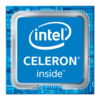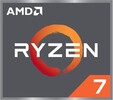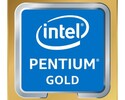Intel Celeron 5205U vs AMD Ryzen 7 3700U vs Intel Pentium Gold 6405U
Intel Celeron 5205U
► remove from comparison
The Intel Celeron 5205U is a power efficient entry-level dual-core SoC for notebooks based on the Comet Lake (CML-U) generation and was announced in October 2019. Compared to the similar Whiskey Lake Celeron 4205U processors, the difference is the higher clock speed (+100 MHz) and support for faster memory. The processor cores are clocked at only 1.9 GHz (no Turbo) and don't support SMT / HyperThreading (so only 2 threads). More information on Comet Lake and all the models and articles on it can be found here.
The integrated graphics adapter is still the same as in the previous generations. It is called only Intel UHD Graphics but is still the same Intel UHD Graphics 610 like in the Pentium 4205U. Furthermore, the SoC integrates a VP9 and H.265 de- and encoder and an integrated dual channel LPDDR3-2133/DDR4-2400 memory controller (compared to DDR4-2666 in the faster and costlier Core i3/i5/i7 processors).
Performance
While we have not tested a single system powered by the 5205U as of August 2023, it's safe to expect the chip to be about half as fast as the Core i3-10110U (Comet Lake, 2 cores, 4 threads, up to 4.1 GHz). Which is nothing to write home about, really, as of mid 2022.
Power consumption
This Celeron has a default TDP, also known as the long-term power limit, of 15 W. Intel officialy allows laptop manufacturers to reduce that value somewhat, 12.5 W being the lower limit, resulting in lower clock speeds and lower performance. Unlike most Comet Lake family processors, Celeron 5205U is fairly likely to actually stick to that limitation as its cores are not Boost-enabled.
Last but not the least, this CPU is manufactured on an old, as of late 2022, 14 nm Intel process making for subpar energy efficiency.
AMD Ryzen 7 3700U
► remove from comparison
The AMD Ryzen 7 3700U is a mobile SoC that was announced in January 2019. It combines four Zen+ cores (8 threads) clocked at 2.3 GHz to 4 GHz with a Radeon RX Vega 10 graphics adapter with 10 CUs (640 shaders) clocked at up to 1,400 MHz. Specified at 15 Watt TDP, the SoC is intended for thin mid-range laptops. In Chromebooks, AMD calles the APU AMD Ryzen 7 3700C, but with the exact same specifications (and performance).
The Picasso SoCs use the Zen+ microarchitecture with slight improvements that should lead to a 3% IPC (performance per clock) improvements.
The integrated dual-channel memory controller supports up to DDR4-2400 memory. As the features of the Picasso APUs are the same compared to the Raven Ridge predecessors, we point to our Raven Ridge launch article.
Performance
The average 3700U in our database is a solid mid-range CPU as of early 2021, its multi-thread benchmark scores matching those of the Core i5-10310U and the Core i5-1035G7 (the Ryzen 5 PRO 3500U is found close nearby as well). This Ryzen 7 is good for more than just binge-watching Netflix and writing e-mails. Just do not expect it to be as fast as a Core i7-11800H.
Thanks to its decent cooling solution and sufficiently high CPU power limits, the ThinkPad E595 is among the fastest laptops powered by the 3700U that we know of. It can be up to 50% faster in CPU-bound workloads than the slowest system featuring the same chip in our database, as of August 2023.
Power consumption
This Ryzen 7 series chip has a default TDP of 15 W (also known as the long-term power limit). This can be changed by a laptop manufacturer to anything between 12 W and 35 W with clock speeds and performance changing accordingly as a result. Either way, that's a little too high to allow for passively cooled designs.
Last but not the least, the Ryzen 7 3700U is manufactured on a 12 nm process for lower-than-average, as of mid-2023, energy efficiency.
Intel Pentium Gold 6405U
► remove from comparison
The Intel Pentium Gold 6405U is a power efficient entry-level dual-core SoC for notebooks based on the Comet Lake (CML-U) generation and was announced in October 2019. Compared to the similar Whiskey Lake Pentium 5405U processors, the difference is the higher clock speed (+100 MHz) and support for faster memory. The processor cores are clocked at 2.4 GHz (no Turbo). Thanks to HyperThreading 4 threads can be used. More information on Comet Lake and all the models and articles on it can be found here.
Due to the 100 MHz higher clock speed, the Pentium Gold 6405U should be slightly faster than the old Pentium 5405U and therefore in the entry level of mobile processors. The missing Turbo and only two cores are definitely a downside and therefore the CPU is best used for simple tasks like browsing and office programs. Compared to the faster Core i3, i5 and i7 Comet Lake models, the Pentium does not support SSE (2).
The integrated graphics card is still the same as in the previous generations. It is called only Intel UHD Graphics but is still the same Intel UHD Graphics 610 like in the Pentium 5405U. Furthermore, the SoC integrates a VP9 and H.265 de- and encoder and an integrated dual channel LPDDR3-2133/DDR4-2400 memory controller (compared to DDR4-2666 in the faster Core i3).
The chip is still produced in the 14nm++ process as Whiskey Lake. The TDP (PL1) is specified at 15 Watts but can be lowered to 12.5 Watt although the CPU then only runs at 800 MHz.
| Model | Intel Celeron 5205U | AMD Ryzen 7 3700U | Intel Pentium Gold 6405U | ||||||||||||||||||||||||||||||||||||||||||||||||||||||||||||||||||||||||||||||||||||||||||||||||||||||||
| Codename | Comet Lake-U | Picasso-U (Zen+) | Comet Lake-U | ||||||||||||||||||||||||||||||||||||||||||||||||||||||||||||||||||||||||||||||||||||||||||||||||||||||||
| Series | Intel Comet Lake | AMD Picasso (Ryzen 3000 APU) | Intel Comet Lake | ||||||||||||||||||||||||||||||||||||||||||||||||||||||||||||||||||||||||||||||||||||||||||||||||||||||||
| Series: Comet Lake Comet Lake-U |
|
|
| ||||||||||||||||||||||||||||||||||||||||||||||||||||||||||||||||||||||||||||||||||||||||||||||||||||||||
| Clock | 1900 MHz | 2300 - 4000 MHz | 2400 MHz | ||||||||||||||||||||||||||||||||||||||||||||||||||||||||||||||||||||||||||||||||||||||||||||||||||||||||
| Cores / Threads | 2 / 2 | 4 / 8 | 2 / 4 | ||||||||||||||||||||||||||||||||||||||||||||||||||||||||||||||||||||||||||||||||||||||||||||||||||||||||
| TDP | 15 Watt | 15 Watt | 15 Watt | ||||||||||||||||||||||||||||||||||||||||||||||||||||||||||||||||||||||||||||||||||||||||||||||||||||||||
| Technology | 14 nm | 12 nm | 14 nm | ||||||||||||||||||||||||||||||||||||||||||||||||||||||||||||||||||||||||||||||||||||||||||||||||||||||||
| max. Temp. | 100 °C | 105 °C | 100 °C | ||||||||||||||||||||||||||||||||||||||||||||||||||||||||||||||||||||||||||||||||||||||||||||||||||||||||
| Socket | BGA1528 | FP5 | FCBGA1528 | ||||||||||||||||||||||||||||||||||||||||||||||||||||||||||||||||||||||||||||||||||||||||||||||||||||||||
| Features | LPDDR3-2133/DDR4-2400 RAM, PCIe 2, 4 GT/s bus, MMX, SSE, SSE2, SSE3, SSSE3, SSE4.1, SSE4.2, AVX, AVX2, BMI2, ABM, FMA, ADX, VMX, SMEP, SMAP, MPX, EIST, TM1, TM2, SST, AES-NI, RDRAND, RDSEED, SGX | DDR4-2400, PCIe 3, MMX, SSE, SSE2, SSE3, SSSE3, SSE4A, SSE4.1, SSE4.2, AVX, AVX2, BMI2, ABM, FMA, ADX, SMEP, SMAP, SMT, CPB, AES-NI, RDRAND, RDSEED, SHA, SME | Dual-Channel DDR4 Memory Controller, HyperThreading, AVX2, Quick Sync, Virtualization, AES-NI | ||||||||||||||||||||||||||||||||||||||||||||||||||||||||||||||||||||||||||||||||||||||||||||||||||||||||
| iGPU | Intel UHD Graphics 610 (300 - 900 MHz) | AMD Radeon RX Vega 10 ( - 1400 MHz) | Intel UHD Graphics 610 (300 - 900 MHz) | ||||||||||||||||||||||||||||||||||||||||||||||||||||||||||||||||||||||||||||||||||||||||||||||||||||||||
| Architecture | x86 | x86 | x86 | ||||||||||||||||||||||||||||||||||||||||||||||||||||||||||||||||||||||||||||||||||||||||||||||||||||||||
| $107 U.S. | $161 U.S. | ||||||||||||||||||||||||||||||||||||||||||||||||||||||||||||||||||||||||||||||||||||||||||||||||||||||||||
| Announced | |||||||||||||||||||||||||||||||||||||||||||||||||||||||||||||||||||||||||||||||||||||||||||||||||||||||||||
| Manufacturer | ark.intel.com | www.amd.com | ark.intel.com | ||||||||||||||||||||||||||||||||||||||||||||||||||||||||||||||||||||||||||||||||||||||||||||||||||||||||
| L1 Cache | 384 KB | 256 KB | |||||||||||||||||||||||||||||||||||||||||||||||||||||||||||||||||||||||||||||||||||||||||||||||||||||||||
| L2 Cache | 2 MB | 1 MB | |||||||||||||||||||||||||||||||||||||||||||||||||||||||||||||||||||||||||||||||||||||||||||||||||||||||||
| L3 Cache | 4 MB | 2 MB | |||||||||||||||||||||||||||||||||||||||||||||||||||||||||||||||||||||||||||||||||||||||||||||||||||||||||
| Transistors | 4500 Million |
Benchmarks
Average Benchmarks Intel Celeron 5205U → 0% n=0
Average Benchmarks AMD Ryzen 7 3700U → 0% n=0
Average Benchmarks Intel Pentium Gold 6405U → 0% n=0
* Smaller numbers mean a higher performance
1 This benchmark is not used for the average calculation













